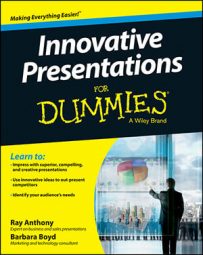You may be wondering in my innovative presentation, “What do I do with my hands?” Rest assured, with some imagination, there are practically unlimited gestures you can use in a significant way.
Size, shape, or dimension of gestures in innovative presentations
Visualize how using gestures could add to the message in the following two statements:
“Our new quantum computer is the most powerful of its kind in the world, yet small.” (Use gestures to show its height, depth, and width.)
“Graphene is a miracle material, and we’re close to manufacturing it in large quantity. It is a honeycomb lattice made of carbon atoms — only one atom thick. This nanotechnology substance is incredibly strong, light, nearly transparent, and an excellent conductor of electricity and heat. A billion layers of it are only this thin.” (Use your thumb and forefinger to show the small thickness.)
Direction of gestures in innovative presentations
Gestures can show that something is up, down, right, left, sideways, slanted, curved, swerving, spiraling, or wavy — for a few examples. Think about how you might use gestures to show something increasing, decreasing, or standing still, such as the following:
“We have a choice. We can choose to grow slowly by playing it extra safe (the presenter extends his entire arm out at a small angle like a bent graph line), or we can innovate, make some mistakes, quickly learn from them, and grow like this.” (He now extends his arm out with a much steeper angle upwards like a trend line of accelerated growth.)
“First the company goes in this direction (presenter walks to the left). Then goes here (presenter turns and walks right). If that isn’t working, we transition (he now walks in the opposite direction). We should be implementing something that does not look like this (he is waving his arms in different directions). Here’s what we need to do.” (The presenter points straight ahead and walks perfectly straight in that direction.)
Motion, movement, or activity of gestures in innovative presentations
Picture yourself describing and showing people how to play golf, tennis, bowling, or some other sport or training someone how to use a tool or product. You use your entire body with a focus on your arms and hands to illustrate an activity. These gestures make you much more interesting, regardless of your topic. Think about how, in your presentation, adding these movements and motions might better reinforce your points:
Back and forth
Grabbing
Holding
Lifting
Pulling, pushing
Round and round
Spiraling
Stopping
Turning, screwing, twisting
Zigzagging
Notice how a particular motion can add meaning to these types of examples:
“In a moment, I will show you a video of how our new 3-D printer creates complex designs using our new technology and mechanism. Current printers do this. (The presenter uses an up-and-down and side-to-side motion to demonstrate how a nozzle prints material.)
But our system does this. (He now uses both hands in a back and forth way as if he were moving a sheet of metal.) We have a metal plate with over 100 nozzles, each which can feed a different substance — such as metal, plastic, rubber, or glass — to deposit that material 60 times faster and 300 percent more accurately. Look at the two-minute video to see what I mean.”
“Regarding supply-chain management in our company, supply was trying to catch up with runaway demand (presenter uses a gesture of going around and around) and never did quite make it.”
Feeling and intensity of gestures in innovative presentations
These gestures can be captivating when a speaker uses his entire body to help describe, amplify, and focus on an intended, meaningful emotion —enthusiasm, rejection, openness, or frustration — connected to a key point being made. Here are two examples:
“We have got to fight (presenter waves a clenched fist) these suffocating regulations that are destroying our businesses and jobs!”
“Our department must aggressively cut and clash (presenter uses a abrupt chopping motion) this out-of-control waste that’s robbing us of profits!”

